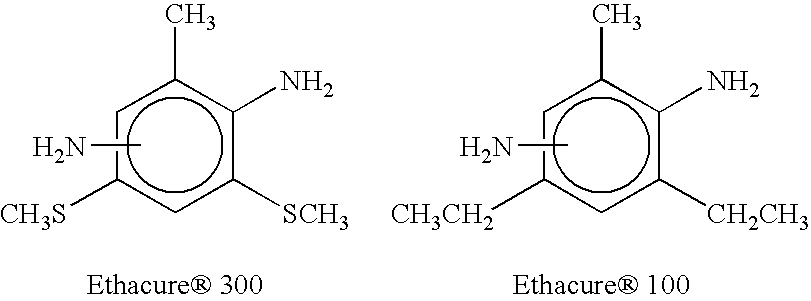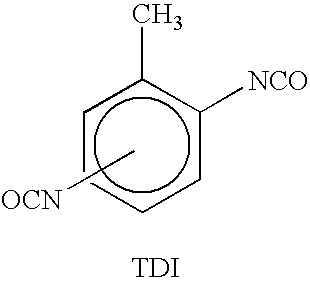Polyurethane material for two and three piece golf balls and method
a polyurethane and golf ball technology, applied in the field of polyurethane, can solve the problems of increasing material cost, balata-type materials are expensive, and the use of balata or transpolyisoprene-based compounds is subject to substantial drawbacks, so as to improve durability and resilience over balata. , the effect of improving the quality of the material
- Summary
- Abstract
- Description
- Claims
- Application Information
AI Technical Summary
Benefits of technology
Problems solved by technology
Method used
Image
Examples
examples 2-4
[0110] Additional tests were run using the same low free TDI prepolymer with altered blend ratios of Ethacure 300 / Ethacure 100. In each test, the prepolymer was heated to 140 .degree.F. and the curative blend was maintained at room temperature before being mixed. The tests were conducted to determine the blend effects on gel time and exothermic reaction.
[0111] When the blend ratio was set at 60:40 (E100 to E300), a gel time of 55-60 seconds was achieved. The exothermic reaction reached 145.degree. F. A 70:30 blend ratio produced a gel time of approximately 50 seconds and an exothermic reaction that reached 156.degree. F. Lastly, an 80:20 blend ratio produced a gel time of approximately 45 seconds and an exothermic reaction that reached 165.degree. F. All of the polyurethane end products of these tests were determined to have physical characteristics similar to those of the polyurethane produced using the 50:50 curing agent blend ratio.
[0112] These test results conclusively demonstra...
PUM
| Property | Measurement | Unit |
|---|---|---|
| Fraction | aaaaa | aaaaa |
| Diameter | aaaaa | aaaaa |
Abstract
Description
Claims
Application Information
 Login to View More
Login to View More - R&D
- Intellectual Property
- Life Sciences
- Materials
- Tech Scout
- Unparalleled Data Quality
- Higher Quality Content
- 60% Fewer Hallucinations
Browse by: Latest US Patents, China's latest patents, Technical Efficacy Thesaurus, Application Domain, Technology Topic, Popular Technical Reports.
© 2025 PatSnap. All rights reserved.Legal|Privacy policy|Modern Slavery Act Transparency Statement|Sitemap|About US| Contact US: help@patsnap.com



